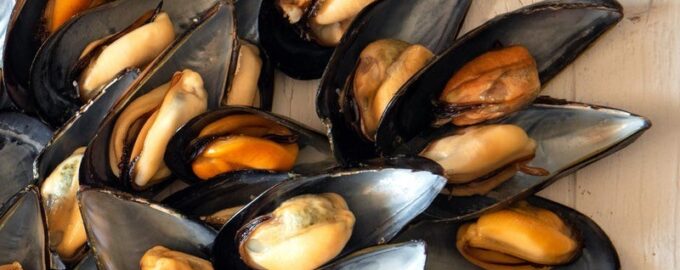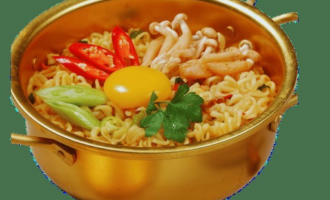Mastering the Art of Gochujang Sauce: A Step-by-Step Guide
MASTERING THE ART OF GOCHUJANG SAUCE: A STEP-BY-STEP GUIDE
Gochujang is a traditional Korean fermented chili paste that is known for its rich, savory flavor with a hint of sweetness and a kick of heat․ It is a versatile ingredient that can elevate any dish, from marinades to dips, and even soups․ In this guide, we will take you through the steps of making your own gochujang sauce at home․
WHAT IS GOCHUJANG?
Gochujang is made from a blend of red chili powder, glutinous rice, fermented soybeans, and salt․ This unique combination gives it a thick texture and complex flavor profile․ Gochujang is often used in Korean dishes like bibimbap, tteokbokki, and as a base for various sauces․
INGREDIENTS NEEDED
To make gochujang sauce, you will need the following ingredients:
– ½ cup gochujang (Korean chili paste)
– 2 tablespoons honey or sugar
– 2 tablespoons soy sauce
– 1 tablespoon sesame oil
– 1 tablespoon rice vinegar
– 1 teaspoon minced garlic
– 1 teaspoon sesame seeds (optional)
STEP-BY-STEP INSTRUCTIONS
STEP 1: GATHER YOUR INGREDIENTS
Before you start, make sure you have all the ingredients at hand․ This will make the process smoother and more enjoyable․
STEP 2: MIX THE BASE INGREDIENTS
In a medium mixing bowl, combine the gochujang, honey (or sugar), and soy sauce․ Use a whisk or a spoon to mix them until they are well blended․
STEP 3: ADD THE FLAVOR ENHANCERS
Next, add the sesame oil, rice vinegar, and minced garlic to the bowl․ These ingredients will enhance the flavor of your gochujang sauce․
STEP 4: WHISK UNTIL SMOOTH
Continue to whisk the mixture until it becomes a smooth, cohesive sauce․ If the sauce is too thick for your liking, you can add a little bit of water to achieve your desired consistency․
STEP 5: TASTE AND ADJUST
Now it’s time to taste your gochujang sauce; Adjust the sweetness, saltiness, or spiciness according to your preference․ You can add more honey for sweetness, soy sauce for saltiness, or more gochujang for heat․
STEP 6: ADD SESAME SEEDS (OPTIONAL)
If you like, you can sprinkle some sesame seeds into the sauce for added texture and flavor․ Mix them in gently․
STORING YOUR GOCHUJANG SAUCE
Once you have made your gochujang sauce, you can store it in an airtight container in the refrigerator․ It will last for about 2 weeks․ The flavors will continue to develop over time, making it even more delicious․
WAYS TO USE GOCHUJANG SAUCE
This versatile sauce can be used in a variety of ways:
– As a marinade for meats or tofu
– Diluted with water as a dipping sauce for dumplings
– Mixed into stir-fries for added flavor
– In salad dressings for a spicy kick
– As a base for soups or stews
CONCLUSION
Mastering the art of gochujang sauce is not only easy but also incredibly rewarding․ With just a few ingredients and some simple steps, you can create a sauce that enhances the flavor of many dishes․ Don’t be afraid to experiment with the ratios to find the perfect balance for your palate․ Enjoy your culinary journey into Korean cuisine!
HEALTH BENEFITS OF GOCHUJANG
Aside from its incredible flavor, gochujang also offers several health benefits․ Here are a few noteworthy aspects:
– Rich in Vitamins and Minerals: Gochujang is made from fermented ingredients, which can provide essential vitamins and minerals, including B vitamins, iron, and calcium․
– Boosts Metabolism: The presence of capsaicin in red chili peppers can help stimulate metabolism, potentially aiding in weight management․
– Probiotic Benefits: Fermented foods, like gochujang, can promote gut health by supporting beneficial bacteria in the digestive system․
– Antioxidant Properties: The ingredients in gochujang contain antioxidants, which can help combat oxidative stress in the body․
TIPS FOR CUSTOMIZING YOUR GOCHUJANG SAUCE
Once you’re comfortable with the basic recipe, consider these tips for customizing your gochujang sauce:
– Vary the Sweetness: Depending on your dish, you can experiment with different sweeteners such as maple syrup or agave nectar to create unique flavor profiles․
– Incorporate Fresh Herbs: Adding chopped green onions, cilantro, or fresh basil can provide a fresh twist to your sauce․
– Experiment with Acidity: For a tangier flavor, try substituting lime juice or apple cider vinegar for rice vinegar․
– Add Nuts or Seeds: Chopped peanuts or toasted sesame seeds can add a delightful crunch and enhance the flavor․
GOCHUJANG SAUCE IN KOREAN CUISINE
Gochujang is a staple in Korean cuisine and plays an integral role in many traditional dishes․ Here are some classic Korean recipes where gochujang sauce shines:
– Bibimbap: A mixed rice dish topped with vegetables, meat, and a fried egg, all enhanced with gochujang sauce for a spicy kick․
– Tteokbokki: Spicy rice cakes stir-fried with gochujang sauce, showcasing its thick, savory flavor․
– Korean BBQ: Use gochujang as a marinade for meats, adding depth and flavor to grilled dishes․
FINAL THOUGHTS
Making your own gochujang sauce is not only a fun culinary project but also a way to bring the vibrant flavors of Korean cuisine into your kitchen․ With a few simple ingredients and a little creativity, you can create a sauce that is uniquely yours․ Whether you use it in traditional dishes or experiment with your own recipes, gochujang sauce is sure to be a delightful addition to your culinary repertoire․ So gather your ingredients and start exploring the endless possibilities that this versatile sauce has to offer!
EXPLORE FUSION CUISINE WITH GOCHUJANG
In recent years, gochujang has gained popularity beyond traditional Korean dishes, making its way into fusion cuisine․ Here are some creative ways to incorporate gochujang sauce into your cooking:
– Gochujang Tacos: Use gochujang as a marinade for grilled chicken or tofu, then serve it in soft tortillas with fresh veggies and a drizzle of lime juice․
– Spicy Gochujang Pasta: Mix gochujang with olive oil, garlic, and cream to create a spicy pasta sauce that will tantalize your taste buds․
– Gochujang Hummus: Blend chickpeas with gochujang, tahini, lemon juice, and garlic for a unique twist on traditional hummus, perfect for dipping․
– Gochujang Glazed Salmon: Brush salmon fillets with gochujang sauce before baking for a sweet and spicy flavor that pairs beautifully with rice․
GOCHUJANG SAUCE AND FOOD PAIRINGS
To maximize the flavors of your gochujang sauce, consider pairing it with complementary ingredients:
– Vegetables: Gochujang pairs well with a variety of vegetables, including broccoli, carrots, bell peppers, and bok choy․ Stir-fry or roast them with gochujang for a delicious side dish․
– Proteins: Marinate beef, chicken, pork, or tofu in gochujang sauce for a flavorful main course․ The umami from the sauce enhances the natural flavors of the proteins․
– Rice and Noodles: Use gochujang sauce to spice up fried rice or noodle dishes․ Its thick consistency clings well to grains and pasta, ensuring every bite is packed with flavor․
– Eggs: Drizzle gochujang sauce over scrambled eggs or a fried egg for breakfast, adding an exciting twist to your morning routine․
Mastering gochujang sauce opens the door to a world of culinary possibilities․ This versatile ingredient not only enhances the flavor of traditional Korean dishes but also invites creativity in fusion cuisine․ By understanding its unique characteristics and experimenting with various recipes, you can incorporate gochujang into your cooking repertoire with ease․
Whether you’re preparing a simple meal or an elaborate feast, gochujang sauce can add that perfect touch of heat and depth․ So, roll up your sleeves, gather your ingredients, and embark on a flavorful journey that celebrates the art of gochujang!
EXPLORING REGIONAL VARIATIONS OF GOCHUJANG
As you delve deeper into the world of gochujang, you may discover that different regions in Korea have their own unique takes on this beloved ingredient․ Here are a few regional variations that showcase how local ingredients and culinary traditions influence the flavor and texture of gochujang:
– Jeolla-do Gochujang: Known for its rich flavor, Jeolla-do gochujang often incorporates additional ingredients like perilla seeds, giving it a nutty aroma and a slightly thicker consistency․
– Gyeongsang-do Gochujang: This variation tends to be spicier and saltier, reflecting the coastal region’s penchant for bold flavors․ It often uses dried red chili peppers from the region, enhancing the heat․
– Chungcheong-do Gochujang: This style is characterized by a sweeter profile, often made with a higher proportion of sweeteners like rice syrup or honey, making it ideal for marinades and dipping sauces․
CREATING A GOCHUJANG TASTING EXPERIENCE
To fully appreciate the nuances of gochujang, consider organizing a tasting experience at home․ Here’s how you can do it:
– Gather a Selection of Gochujang: Purchase different brands or homemade gochujang from various regions in Korea․ Look for variations in spice level, sweetness, and texture․
– Prepare Tasting Dishes: Create small plates featuring a variety of dishes that highlight gochujang, such as bibimbap, tteokbokki, and spicy grilled meats․
– Pair with Drinks: Complement the tasting with drinks that enhance the flavors, such as Korean rice wine (makgeolli) or light beers that can balance the heat․
– Take Notes: Encourage guests to jot down their thoughts on each gochujang variant, discussing their preferences and what dishes they enjoyed the most․
GOCHUJANG IN MODERN CUISINE
The influence of gochujang has permeated modern cuisine, inspiring chefs and home cooks alike to incorporate its unique flavor profile into various dishes across the globe․ Here are some contemporary uses of gochujang:
– Gochujang BBQ Sauce: Combining gochujang with traditional BBQ ingredients like ketchup, vinegar, and spices creates a spicy, tangy sauce perfect for grilling․
– Gochujang Salad Dressings: Blending gochujang with yogurt, lime juice, and olive oil produces a creamy dressing with a kick, ideal for drizzling over fresh salads․
– Gochujang Pizza: Topping a pizza with gochujang sauce instead of traditional tomato sauce can give a unique twist, especially when paired with ingredients like kimchi and mozzarella․
FINAL REMARKS
Mastering the art of gochujang sauce not only enhances your culinary skills but also allows you to explore a vibrant aspect of Korean culture․ As you experiment with this dynamic ingredient, remember that the key to making a great gochujang sauce lies in balance – the perfect blend of heat, sweetness, and umami․ With practice and creativity, you’ll find endless ways to incorporate gochujang into your meals, delighting your taste buds and impressing your friends and family․
So, don’t hesitate to dive into the world of gochujang․ From traditional dishes to modern interpretations, this flavorful sauce will surely elevate your cooking to new heights!






